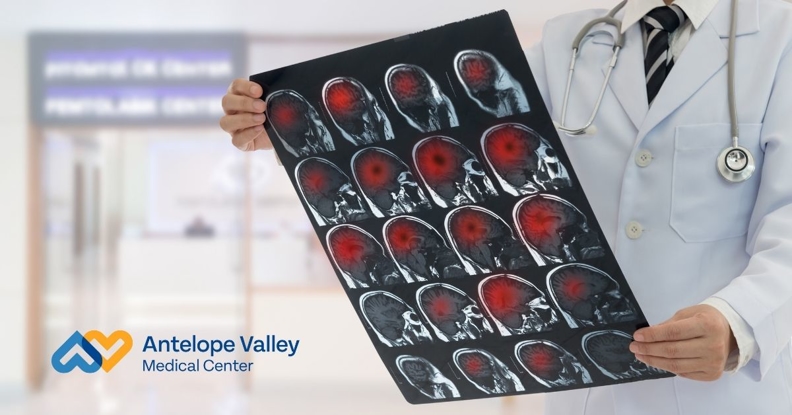What to Do in Case of a Stroke
- Category: Preventive Care
- Posted On:
- Written By: Antelope Valley Medical Center
.1).jpg)
A stroke is a medical emergency that demands urgent attention. When a stroke occurs, the blood flow to a part of the brain is interrupted, leading to potential damage to brain tissue. Acting quickly can save lives and minimize long-term effects. Understanding the symptoms, knowing how to respond, and adopting strategies to lower your risk are key to managing and preventing strokes.
Recognizing the Symptoms of a Stroke
Time plays a critical role in stroke treatment. The faster a stroke is identified, the greater the chances of a positive outcome. The acronym BEFAST provides an easy way to recognize the main warning signs:
- B - Balance: If you are experiencing a sudden loss of balance or coordination, you could be experiencing a stroke. Try walking in a straight line to see if you are able to maintain coordination.
- E - Eyes: A loss of vision, or blurred or double vision, could signify a stroke. Like a visit to the eye doctor, ask the individual to read something from far away, or to repeat how many fingers you are holding up to see if they are experiencing a sudden change in vision.
- F - Face Drooping: Check if one side of the face is drooping or feels numb. Ask the person to smile. If the smile appears uneven, it could be a sign of a stroke.
- A - Arm Weakness: Is one arm weak or numb? Ask the individual to raise both arms. Difficulty keeping one arm raised might indicate a stroke.
- S - Speech Difficulty: Slurred or garbled speech, or the inability to speak, are key warning signs. Ask the person to repeat a simple sentence and notice if the words are unclear or incorrect.
- T - Time to Call 911: If you observe any of these symptoms, call emergency services immediately. Time is critical.
Additional symptoms may include:
- Sudden confusion
- Trouble speaking
- Dizziness
- Severe headache
Importantly, strokes can present differently in different individuals, so it’s essential to remain vigilant if anything unusual occurs.
Related: Strokes vs. Heart Attacks: Understanding the Difference
What to Do If You or Someone Else Experiences a Stroke
When a stroke happens, every second counts. Here’s what you should do if you suspect a stroke:
Call Emergency Services Immediately
Dial 911 at the first sign of a stroke. Inform the operator of the symptoms and emphasize the need for immediate medical assistance. Do not attempt to transport the individual to the hospital yourself, as paramedics can provide life-saving care during transit.
Remain Calm and Comfortable
Encourage the person to sit or lie down in a safe, comfortable position. Avoid giving them food, drink, or medication, as these can interfere with medical treatment. Most importantly, stay calm to help them stay calm.
Note the Time of Onset
Take note of when the symptoms started or when the person was last seen well. This information is crucial for healthcare providers, as certain treatments, like clot-busting medication, need to be administered within a specific time frame.
Ensure a Clear Airway
If the individual has difficulty breathing or becomes unconscious, gently position them on their side to prevent choking. Be prepared to perform CPR if their breathing stops, but only if you're trained to do so.
Stay with the Person Until Help Arrives
Provide reassurance and monitor their condition. If symptoms worsen, update the emergency team when they arrive.
Do not wait to see if symptoms go away. Swift action is vital. Delays can result in more severe brain damage and limited treatment options.
Lowering Your Risk of Stroke
While some risk factors for strokes, such as age or family history, cannot be controlled, there are practical steps you can take to reduce your overall risk. Preventive measures are especially important since strokes are one of the leading causes of disability and death.
Manage Chronic Conditions
High blood pressure is the leading cause of strokes. Keep it under control through lifestyle changes and prescribed medication.
Diabetes management also lowers stroke risk. Regularly check your blood sugar levels and follow your doctor’s advice.
Atrial fibrillation (AFib), an irregular heart rhythm, significantly increases stroke risk. Be proactive about managing heart conditions.
Quit Smoking
Smoking damages blood vessels and accelerates the buildup of plaque, increasing the likelihood of a stroke. Quitting smoking can improve your overall health and dramatically reduce stroke risk over time.
Maintain a Healthy Lifestyle
- Nutrition: Follow a balanced diet rich in fruits, vegetables, whole grains, and lean protein. Limit salt and saturated fat to keep cholesterol and blood pressure levels in check.
- Exercise: Aim for at least 30 minutes of moderate physical activity on most days of the week. Physical activity helps regulate weight and improve cardiovascular health.
- Weight Management: Being overweight or obese increases the risk of both high blood pressure and diabetes, which are major contributors to strokes.
Limit Alcohol Consumption
Excessive alcohol intake raises blood pressure and can lead to an irregular heartbeat. Stick to moderate drinking guidelines to minimize your risk.
Monitor Stress Levels
Chronic stress contributes to higher blood pressure and unhealthy habits like poor eating or smoking. Incorporate stress-relieving practices such as mindfulness, yoga, or deep breathing exercises into your routine.
Regular Check-Ups
Routine health visits can detect and address risk factors before they escalate. Work with your healthcare provider to routinely monitor your heart health, blood pressure, and cholesterol levels.
Advanced Stroke Care in Lancaster
A quick response when you or someone you love is experiencing a stroke is vital. At Antelope Valley Medical Center, our stroke response team treats more than 700 cases of stroke every year, so we know how to care for patients and treat even the most severe types of stroke. We are proud to have achieved the Gold Seal of Approval for its Advanced Stroke Program accredited from The Joint Commission and the Los Angeles County Emergency Medical Services Agency and aim to foster better stroke care for our patients. Antelope Valley Medical Center is committed to providing timely care to quickly treat acute stroke victims.
If you are at high risk of stroke, consult with your healthcare provider about safeguarding your health and taking preventive measures. Visit us online to learn more about our stroke center or about our services.


.jpg)
